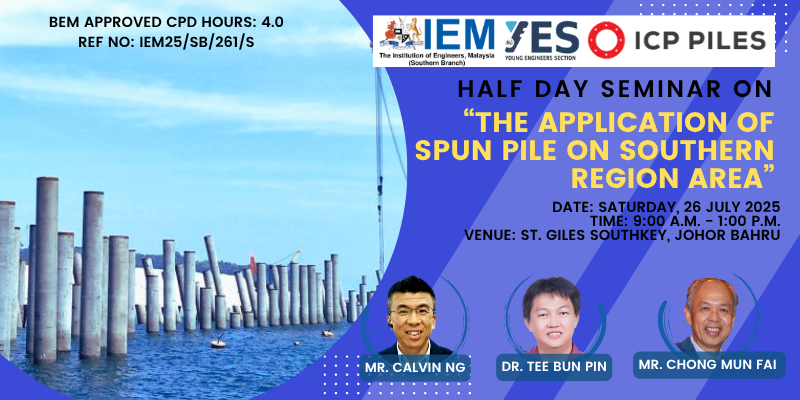
Date : 26 July 2025 (Saturday)
Time : 9:00 a.m. – 1:00 p.m.
Venue : St. Giles Southkey, Johor Bahru
Synopsis
Join us for an insightful half-day seminar focused on the critical role of spun piles in the Southern Region of Malaysia. This event will delve into the practical applications, performance, and challenges of PHC spun piles in complex soil conditions. We will also explore advanced testing and monitoring technologies to enhance foundation design and integrity. This seminar aims to equip consultant engineers with practical knowledge and introduce innovative solutions for engineering applications.
Mr. Calvin Ng
General Manager, Industrial Concrete Products Sdn Bhd
Topic: The Application of Pretensioned Spun High-Strength Concrete Piles in the Southern Region
This presentation provides an overview and valuable insights into the application of PHC piles in Johor. It highlights the behaviour of spun piles in alluvial soil profile through case studies. In the case studies, the speaker will present soil profiles, foundation designs, and test results from past projects. The session will address common site challenges in coastal areas, such as pile failure, soil displacement, and foundation settlement. Corrective actions to rectify and minimize these issues during construction activities will be discussed. A key focus will be on proper spun pile installation methods, emphasizing good piling practices to ensure the efficient and effective execution of piling work on site.
Dr. Tee Bun Pin Founder and General Manager, Smart Sensing Technology Sdn Bhd (SST)
Topic: Application of Instrumented Spun Piles Using Distributed Fibre Optic Strain
Sensors: Case Studies in the Southern Region
This presentation discusses the application of spun piles instrumented with distributed fibre optic strain sensors in the southern region, with specific case studies in Kulai, Malaysia and Singapore. The region's subsurface profile is known for its complexity, featuring layers of soft alluvial clay, dense sand, weathered rock, and occasional granite formations. These varying soil conditions pose challenges in pile penetration, accurate capacity prediction, and overall foundation performance.
To address these challenges, distributed fibre optic strain sensing (DFOS) has been adopted as a modern instrumentation method. DFOS enables high-resolution, continuous strain monitoring along the full length of the pile, capturing detailed load transfer mechanisms, including shaft friction and end-bearing mobilization. This method provides valuable data during static load testing, offering deeper insights than traditional discrete instrumentation.
The presentation also highlights the practical aspects of pile and sensor installation, including sensor embedding techniques, grouting, protection during handling, and the challenges associated with installing large-diameter piles. A notable topic covered is the occurrence of false pile set in dense or hard layers, which can mislead depth or capacity interpretations if not properly identified and verified. Complementary testing methods such as the Pile Driving Analyzer (PDA) test and post-installation resting periods are also discussed. Additionally, comparisons between field monitoring results and numerical modelling help validate assumptions and improve the reliability of geotechnical designs. These case studies demonstrate how advanced instrumentation and interpretation methods significantly enhance the understanding of pile behaviour in difficult ground conditions, leading to safer and more cost-effective foundation solutions.
Mr. Chong Mun Fai
Managing Director, Dynamic Pile Testing Sdn Bhd
Topic: Relevance of BTA Value in High-Strain Dynamic Load Testing (PDA)
The High-Strain Dynamic Load Test is commonly specified in contracts documents as a tool to determine pile capacity. In addition to capacity, compressive and tensile stresses during driving can also be computed. Furthermore, the PDA is frequently used to assess a pile’s structural integrity through the BTA value obtained during field testing. The use of BTA for damage detection has advanced to the point where the numerical BTA output from PDA testing is widely adopted as an acceptance criteria for pile’s structural integrity. However, relying solely on the BTA value as an acceptance criterion may lead to misinterpretation of the pile’s condition. This presentation aims to provide Engineers with a deeper understanding of how to interpret the BTA value in conjunction with other parameters and field observations across various types to more accurately evaluate pile’s structural integrity.
Participant fees
IEM Member: RM 50
Non-IEM Member: RM 80
Registration will be on a first-come-first-serve basis. Kindly return the reply slip to the IEM (SB) office before 22 July 2025 together with a non-refundable cheque for the participant fees made payable to The Institution of Engineers, Malaysia (Southern Branch). Alternatively, you could bank-in the participant fees into the Institution’s Maybank Current Account (No. 5-013920-15708), and to facsimile both the Bank-in and Reply Slips to the Institution. The Institution requests all members co-operation in ensuring fees are paid in advance for the seminar. Please also be reminded that fees will not be refunded to absent participants who have paid, and to also note that all reservations must be paid despite participant cancellations. Thank you for your continuous support of the Institution.
DOWNLOAD REGISTRATION FORM